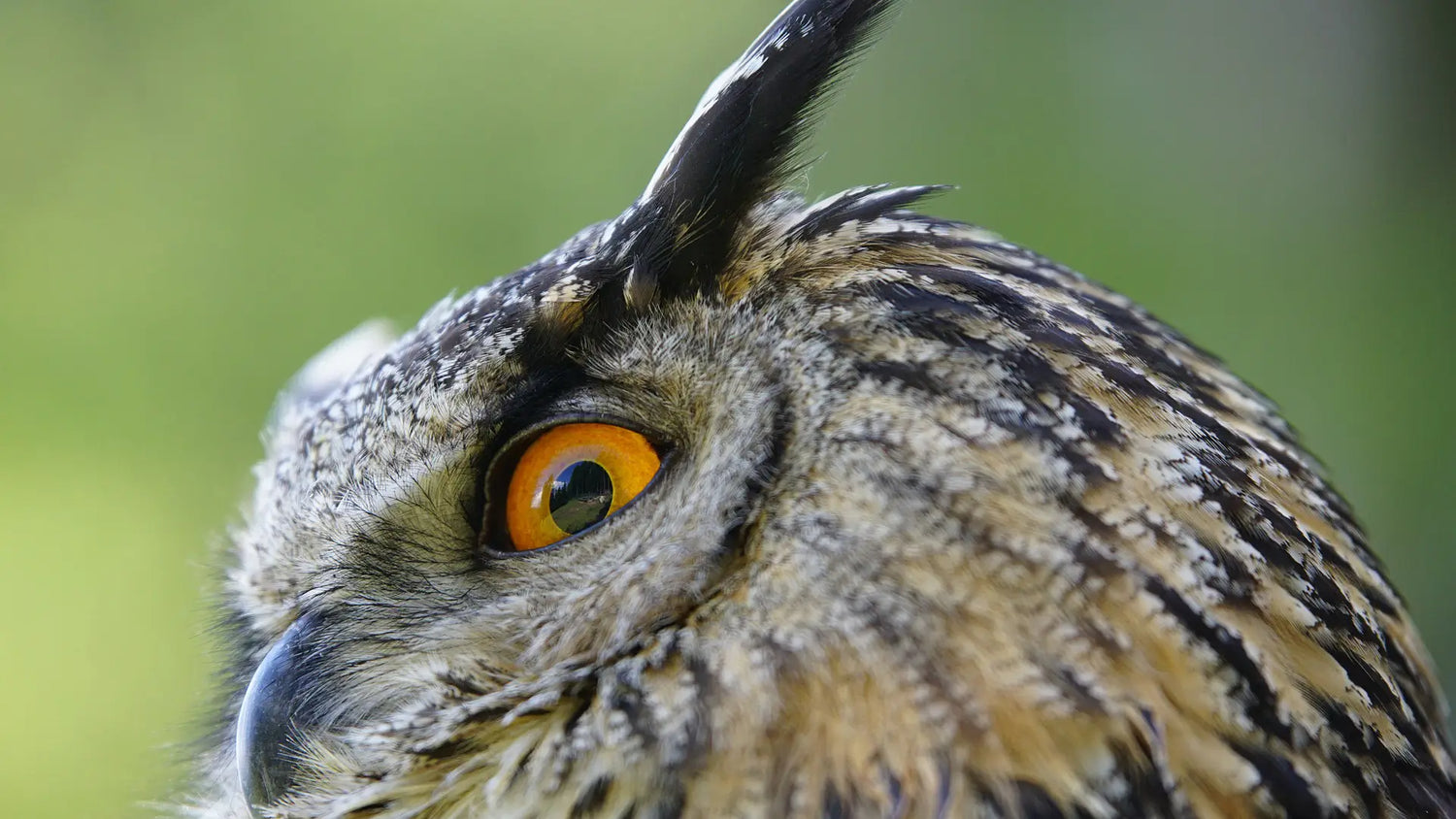Unlike other animals, birds have ears but no outer ears or auricles
Birds, with their awe-inspiring flights and enchanting songs, have long captivated human curiosity. Among the many questions that arise about these feathered creatures, one that stands out is, "Do birds have ears?" In this article, we'll explore the auditory systems of birds, shedding light on their remarkable adaptations and unique hearing abilities.
Where are birds' ears? A Hidden Wonder
Birds possess a remarkable auditory system that sets them apart from humans. Unlike us, birds lack external ears, such as pinnae, which are the visible parts of our ears. Instead, their ears are located on either side of their head, cleverly concealed behind a layer of feathers. These hidden wonders, known as ear canals, are a fascinating aspect of avian anatomy. They play a crucial role in birds' ability to perceive and interpret sounds in their environment. Additionally, these ear canals are guarded and protected by a specialized structure called the operculum, adding to the intriguing nature of birds' ears.
The location of birds' ears, hidden behind their feathers, serves several important functions. The feather coverage acts as a natural barrier, shielding the delicate ear structures from external elements and potential damage. It also helps to minimize wind noise and maintain focus on the sounds that birds need to detect, such as prey calls or vocalizations from other birds.

The Characteristics of Bird Ears: Adaptations for Hearing Excellence
Birds have evolved an array of characteristics in their auditory system that optimize their hearing capabilities. One notable adaptation is the ability to adjust the size of their ear canals. This unique feature provides birds with the ability to finely tune their sensitivity to different frequencies, enabling them to detect and distinguish a wide range of sounds in their surroundings with exceptional precision.
The ability to adjust the size of their ear canals allows birds to adapt to different acoustic environments. For example, birds living in dense forests may have narrower ear canals, which helps them filter out background noise and focus on the specific sounds of interest, such as the songs of potential mates or the calls of nearby prey. On the other hand, birds in open habitats may have wider ear canals, enhancing their ability to detect distant sounds and potential threats.
In addition to the size-adjusting capability, birds have other adaptations that contribute to their hearing excellence. They have a highly developed auditory cortex in their brain, allowing them to process and interpret complex acoustic information effectively. Additionally, they have specialized hair cells in their inner ears that convert sound vibrations into electrical signals, enabling them to perceive even the faintest of sounds.

Beyond Ears: The Role of Feathers in Bird Hearing
Feathers, although primarily known for their role in flight and insulation, also play an unexpected part in bird hearing. Feathers contribute to sound reception by transmitting sound vibrations to the ear canals, enhancing birds' hearing abilities. The intricate arrangement and structure of feathers on a bird's body allow them to effectively capture and transmit sound waves, optimizing their auditory perception.
Feathers act as natural amplifiers, capturing sound vibrations and directing them toward the ear canals. The arrangement of feathers around the head and face can create a funnel-like effect, channeling sound waves directly into the ear openings. This adaptation improves the efficiency of sound reception, allowing birds to detect and localize sounds more accurately.
Furthermore, certain species of birds have specialized facial feathers known as facial discs or ruffs. These feathers have unique structural properties that help to focus and direct sound waves to the ear canals, increasing the bird's ability to pinpoint the source of a sound. This is particularly advantageous for birds of prey, such as owls, that rely heavily on their hearing to locate and capture prey in low-light conditions.

In conclusion, the hidden wonder of birds' ears, concealed behind their feathers, showcases their remarkable adaptations for auditory excellence. The ability to adjust the size of their ear canals, the presence of a highly developed auditory cortex, and the contribution of feathers to sound reception all highlight the complexity and sophistication of avian auditory systems. These adaptations enable birds to excel in their acoustic perception, navigate their environment, communicate effectively, and thrive in their unique avian lifestyles.
FAQs: Unveiling More About Bird Hearing
How Do Birds Hear?
A: Birds hear through their concealed ear canals, which lead to the inner ear, where sound is processed. The vibrations in the air are captured by feathers and transmitted through the ear canals to the inner ear.
Can Birds Hear Better Than Humans?
A: In many cases, birds have a more acute sense of hearing than humans. They can detect a broader range of frequencies, including sounds in the ultrasonic and infrasonic ranges, which are beyond our auditory capabilities.
Do All Birds Have Similar Hearing Abilities?
A: No, the hearing abilities of birds can vary among species. For instance, owls possess exceptional hearing, enabling them to hunt in near darkness. Waterfowl can hear underwater, and some birds can even detect seismic vibrations.
How Do Birds Use Sounds to Communicate?
A: Birds employ sounds for various purposes, such as attracting mates, marking territories, and alerting to potential threats. Different bird species have their unique vocalizations and calls.
Can Birds Go Deaf?
A: Similar to humans, birds can experience hearing loss due to factors like age, exposure to loud noises, or illnesses. However, they do not have the capacity to use hearing aids like we do.
Do Birds Enjoy Music?
A: While it remains unclear whether birds enjoy music as humans do, they do respond to certain melodies. Some birds have been observed to sing in response to human music.
Conclusion
In conclusion, the answer to the question, "Do birds have ears?" is a definitive yes. Birds possess intricate auditory systems, uniquely adapted to their specific needs. These adaptations, along with their exceptional hearing abilities, contribute to the beautiful songs and communication methods of our feathered friends, making them even more fascinating. Birdsong is a testament to the wonders of nature, and it's a privilege to delve into their auditory world.
Birds' auditory and sensory features have always been fascinating, and creating an environment that suits them is the first step to better understanding them. With the HummerHi Smart Hummingbird Feeder, you can not only attract hummingbirds and other bird species but also observe their subtle behaviors and enjoy the joy of interacting with nature.
From Bilantan.com





5 comments
Danielle
I thoroughly enjoyed reading Avian Auditory Systems: A Hidden Marvel. The article concludes with a thought-provoking discussion on the importance of studying bird hearing and its implications for fields such as bioacoustics and conservation. It left me with a newfound appreciation for the complexity and beauty of avian auditory systems. Well-written and informative!
Ted
FAQs: Unveiling More About Bird Hearing is a valuable resource for anyone curious about bird hearing. The article addresses common questions and misconceptions, providing clear and concise answers backed by scientific research. It’s a great reference for both casual readers and bird researchers looking to expand their knowledge.
Jocelyne Wolf
I never realized how important feathers are for bird hearing until I read The Role of Feathers in Bird Hearing. This article explores the unique role feathers play in amplifying and directing sound, enhancing a bird’s ability to detect and locate prey. It’s a captivating piece that sheds light on the intricate mechanisms behind bird hearing.
DG
Adaptations for Auditory Excellence provides a comprehensive overview of how birds have evolved to have such remarkable hearing abilities. The author explains complex concepts in a clear and engaging manner, making it accessible to both bird enthusiasts and those interested in animal physiology. A must-read for anyone wanting to understand the astonishing adaptations of avian species.
Nicole
Avian Auditory Systems: A Hidden Marvel is an incredible read! It delves deep into the fascinating world of bird hearing. I was amazed to learn about the intricate adaptations that birds have for auditory excellence. Highly recommended for anyone curious about the wonders of avian biology.
Leave a comment
All comments are moderated before being published.
This site is protected by hCaptcha and the hCaptcha Privacy Policy and Terms of Service apply.